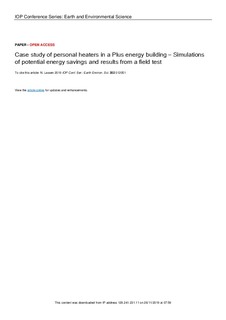| dc.contributor.author | Lassen, Niels | |
| dc.date.accessioned | 2019-11-28T15:01:11Z | |
| dc.date.available | 2019-11-28T15:01:11Z | |
| dc.date.created | 2019-11-21T10:46:20Z | |
| dc.date.issued | 2019 | |
| dc.identifier.issn | 1755-1307 | |
| dc.identifier.uri | http://hdl.handle.net/11250/2630944 | |
| dc.description.abstract | Personal Comfort Systems (PCS) for heating, such as foot warmers, heated chairs and infrared heaters, can compensate for a lowering of up to 10°C in ambient temperatures in a heating situation. They are found to lead to a significant increase in occupant satisfaction with the thermal environment, as they enable for a personalized thermal environment. In this way, the use of PCS systems can ensure occupant satisfaction while widening the temperature dead-band, or difference between heating and cooling set-points in buildings. Several field studies from North America have indicated that the average dead-band between heating and cooling set-points is between 1 and 2 °C, leading to considerable amounts of energy used for over-heating and over- cooling. This kind of systems may therefore be an important contributor towards Plus energy buildings, but they are seldom used. The objectives of this study were (1) to test PCS heaters in a modern Norwegian office environment and see how they are appreciated by office workers and (2) to investigate how large energy savings such systems can contribute to in a Plus energy building. Powerhouse Kjørbo was selected as a case building for the study. Potential energy savings were calculated using energy simulations. The results in this case study were not able to confirm an increase in occupant thermal acceptability rate due to the use of a PCS heater. Interviews of occupants however suggest that PCS heaters are a good solution for improving the satisfaction of the limited number of occupants who have special needs, preferences or are located in a place with lower temperature. In buildings with an effective heating source, such as ground source heat pumps, PCS solutions are not likely to contribute to notable energy savings. In an indirect way, they may however still contribute toward realizing Plus energy buildings as PCS systems can help relax the demands set to other climate installations in the building. This again can allow the use of more environmentally friendly solutions such as utilization of thermal mass, temperature stratification and natural ventilation. They can also reduce installation costs by eliminating the need for more complicated and costly HVAC systems. | nb_NO |
| dc.description.abstract | Case study of personal heaters in a Plus energy building – Simulations of potential energy savings and results from a field test | nb_NO |
| dc.language.iso | eng | nb_NO |
| dc.publisher | IOP Publishing | nb_NO |
| dc.rights | Navngivelse 4.0 Internasjonal | * |
| dc.rights.uri | http://creativecommons.org/licenses/by/4.0/deed.no | * |
| dc.title | Case study of personal heaters in a Plus energy building – Simulations of potential energy savings and results from a field test | nb_NO |
| dc.type | Journal article | nb_NO |
| dc.type | Peer reviewed | nb_NO |
| dc.description.version | publishedVersion | nb_NO |
| dc.source.journal | IOP Conference Series: Earth and Environmental Science (EES) | nb_NO |
| dc.identifier.doi | 10.1088/1755-1315/352/1/012051 | |
| dc.identifier.cristin | 1750315 | |
| dc.relation.project | Norges forskningsråd: 257660 | nb_NO |
| dc.relation.project | Norges forskningsråd: 277048 | nb_NO |
| dc.description.localcode | Content from this work may be used under the terms of theCreative Commons Attribution 3.0 licence. Any further distribution of this work must maintain attribution to the author(s) and the title of the work, journal citation and DOI. Published under licence by IOP Publishing Ltd | nb_NO |
| cristin.unitcode | 194,61,55,0 | |
| cristin.unitname | Institutt for arkitektur og teknologi | |
| cristin.ispublished | true | |
| cristin.fulltext | original | |
| cristin.qualitycode | 1 | |

